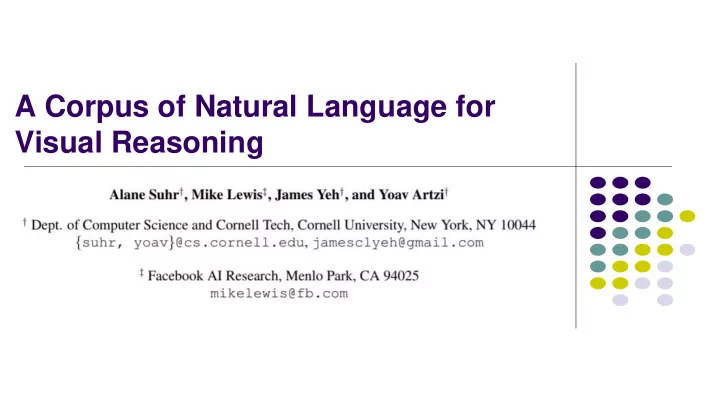

A Corpus of Natural Language for Visual Reasoning
Cornell Natural Language Visual Reasoning Dataset (NLVR) Task : Given a sentence-image pair, determine if a sentence is true or false about the image. One of the grey boxes has exactly There is exactly one tower with a six objects black block at the top Requires reasoning about sets of objects , quantities , colors and spatial relationships Applications: Instructing assembly-line robots to manipulate objects in cluttered environments
More Examples There is blue square touching the There is at least two towers with the bottom of a box same height Goal of the paper: Describing the process of creating the dataset for this new task Reporting the results for several simple models trained on the dataset in order to show the complexity of the data
Dataset Preparation Generation of Structured {"type":"square “, " color ":“black ","x_loc":40,y_loc":80,"size":"20"}, Representation of each {"type ":“square“," color ":“blue“ ,… }, object in an image { …… } Automatic Image Generation Sentence Writing There are at least 3 blue blocks There are 2 towers that contain yellow blocks Manually Annotated Sentence Validation There are at least 3 blue blocks There are 2 towers that contain yellow blocks
Automatic Image Generation Image consists of 3 boxes, each contains 1-8 objects with the following properties: color (black, blue, yellow) , shape ( , , ) size (small, medium, large) , position (x/y coordinate) Number of objects and properties are sampled uniformly Equal number of tower and scatter images are generated Tower image Scatter image ( only square objects forming towers) ( objects are scattered around the scene)
Sentence Writing Annotators are presented with Annotation Task: 4 images at a time Write one sentence to meet the following requirements • It describes (A) Same objects • It describes (B) randomly • It does not describe (C) shuffled • It does not describe (D) • It does not mention the images explicitly (e.g., “In image A ..”) • It does not mention the order of boxes (e.g., “In the rightmost square”) Same objects randomly There is no one correct sentence for this task. If you shuffled can think of more than one sentence submit only one Example: There is one blue triangle touching the bottom of one box
Sentence Validation Attach the sentence to each of the 4 images Randomly Permute the images and the boxes in each image There is one blue triangle or touching the bottom of one box There is one blue triangle or touching the bottom of one box There is one blue triangle or touching the bottom of one box There is one blue triangle or touching the bottom of one box
Data Statistics They collected 3974 unique sentences (one sentence for 4 images) Dataset size = 3974 * 4 * 6 = 95376 ≈ 92244 after pruning sentences images Box permutations The data is prepared by 10 annotators through crowdsourcing framework Upwork Total cost for annotating the data = 5,526 $
Training Models on the data The paper compares several methods to perform the visual reasoning task on the proposed dataset The goal is to show how challenging the data is Three different classes of models are compared: Single modality models: Text-only or Image-only Structured representation models: models trained on structured representation only without image representation e.g. {"type":"square “, " color ":“black"," x_loc":40,y_loc":80,"size":"20 "}, … Image Representation models: models trained on both image and text data (multimodal)
Single Modality Models Majority: Assign the most common label (true) to all examples Text-only: Encode the sentence with RNN (LSTM + softmax) Image-only: Encode the image with CNN (3 convolutional layers + 3 feed-forward layers + softmax)
Structured Representation Models MaxEnt: Compute Maximum entropy classifier using both: Property-based features: (e.g., Topmost/lowest object in box is in this color, Whether any object is touching in any wall in any box) Count-based features (e.g., the number of black triangles, number of objects touching any wall in the image) MLP (Multilayer Perceptron): use same features as MaxEnt and train a model with single-layer perceptron + softmax Image Features + RNN: use object features (color, shape, size) + RNN sentence representation as concatenated feature vector and train two layer perceptron + softmax
Multimodal Models CNN + RNN: Concatenate the CNN image embedding and RNN sentence embedding, and train a multilayer perceptron with a softmax NMN (Neural module networks): neural network that is assembled dynamically by composing shallow network fragments called modules NMNs are originally proposed for Visual Question Answering(VQA) “Deep Compositional Question Answering with Neural Module Networks.” Jacob Andreas, Marcus Rohrbach, Trevor Darrell and Dan Klein. CVPR 2016. https://arxiv.org/pdf/1511.02799.pdf
Neural Module Networks (NMNs) Let’s say we want to answer these two questions: What color is the thing with the same size as the blue cylinder ? Answer: Green Answer: Four How many things are the same size of the ball ?
Neural Module Networks (NMNs) Magic Let’s say we want to answer these two questions What color is the thing with the same size as the blue cylinder ? Auto-generate modules from text Answer: Green Auto-generate modules from text Answer: Four How many things are the same size of the ball
Results Test-P: publicly released test set , Test-U: requires submitting trained models NMN is the best performing model using images (accuracy is only 66.12%) MaxEnt is the best performing in structured representation (when disabling count-based features accuracy drops from 68% to 57%)
Summary The paper introduces Cornell Natural Language Visual Reasoning (NLVR) dataset and task (http://lic.nlp.cornell.edu/nlvr/) The task requires reasoning about colors , shapes , and quantities The paper describes the process of creating the dataset (10 annotators , 5,526$) The paper experiments with various and the best performance is relatively low (67%) which exemplifies the complexity of the data
Recommend
More recommend